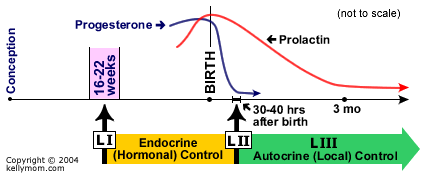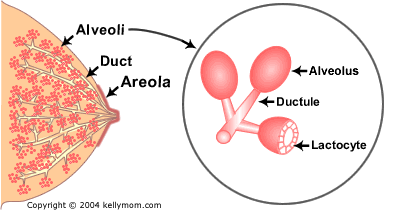Salam,
nak citer pasal bagaimana susu ibu dihasilkan tetapi acik tak larat nak tranlate, takut salah tafsiran. Baiklah dikekalkan dalam bahasa asalnya, iaitu Bahasa Inggeris. Jikalau teman-teman tak berapa nak faham dengan ayat yang panjang-panjang ni, boleh calling-calling aii ye... Selamat membaca, ye!!
In the Beginning...
Endocrine (Hormonal) Control of Milk Synthesis -- Lactogenesis I & II
Milk production doesn’t start out as a supply and demand process. During pregnancy and the first few days postpartum, milk supply is hormonally driven – this is called the endocrine control system. Essentially, as long as the proper hormones are in place, mom will start making colostrum about halfway through pregnancy (Lactogenesis I) and her milk will increase in volume (Lactogenesis II) around 30-40 hours after birth.During the latter part of pregnancy, the breasts are making colostrum, but high levels of progesterone inhibit milk secretion and keep the volume “turned down”. At birth, the delivery of the placenta results in a sudden drop in progesterone/estrogen/HPL levels. This abrupt withdrawal of progesterone in the presence of high prolactin levels cues Lactogenesis II (copious milk production). Other hormones (insulin, thyroxine, cortisol) are also involved, but their roles are not yet well understood. Although biochemical markers indicate that Lactogenesis II commences approximately 30-40 hours after birth, mothers do not typically begin feeling increased breast fullness (the sensation of milk "coming in") until 50-73 hours (2-3 days) after birth.
These first two stages of lactation are hormonally driven – they occur whether or not a mother is breastfeeding her baby.

Established Lactation...
Autocrine (Local) Control of Milk Synthesis -- Lactogenesis III
After Lactogenesis II, there is a switch to the autocrine (or local) control system. This maintenance stage of milk production is also called Lactogenesis III. In the maintenance stage, milk synthesis is controlled at the breast -- milk removal is the primary control mechanism for supply. Milk removal is driven by baby’s appetite. Although hormonal problems can still interfere with milk supply, hormonal levels play a much lesser role in established lactation. Under normal circumstances, the breasts will continue to make milk indefinitely as long as milk removal continues.By understanding how local/autocrine control of milk synthesis works, we can gain an understanding of how to effectively increase (or decrease) milk supply.
What does current research tell us about milk production?
Current research suggests that there are two factors that control milk synthesis:Milk contains a small whey protein called Feedback Inhibitor of Lactation (FIL) – the role of FIL appears to be to slow milk synthesis when the breast is full. Thus milk production slows when milk accumulates in the breast (and more FIL is present), and speeds up when the breast is emptier (and less FIL is present).

The hormone prolactin must be present for milk synthesis to occur. On the walls of the lactocytes (milk-producing cells of the alveoli) are prolactin receptor sites that allow the prolactin in the blood stream to move into the lactocytes and stimulate the synthesis of breastmilk components. When the alveolus is full of milk, the walls expand/stretch and alter the shape of prolactin receptors so that prolactin cannot enter via those receptor sites – thus rate of milk synthesis decreases. As milk empties from the alveolus, increasing numbers of prolactin receptors return to their normal shape and allow prolactin to pass through - thus rate of milk synthesis increases. The prolactin receptor theory suggests that frequent milk removal in the early weeks will increase the number of receptor sites. More receptor sites means that more prolactin can pass into the lactocytes and thus milk production capability would be increased.
Both of the above factors support research findings that tell us:
|
|
How does milk supply vary throughout the day?
Earlier researchers observed that milk volume is typically greater in the morning hours (a good time to pump if you need to store milk), and falls gradually as the day progresses. Fat content tends to increase as the day progresses (Hurgoiu V, 1985). These observations are consistent with current research if we assume the researchers were observing babies with a fairly typical nursing pattern, where baby has a longer sleep period at night and gradually decreases the amount of time between nursing as the day progresses.What does the research tell us about increasing milk supply?
Milk is being produced at all times, with speed of production depending upon how empty the breast is. Milk collects in mom's breasts between feedings, so the amount of milk stored in the breast between feedings is greater when more time has passed since the last feed. The more milk in the breast, the slower the speed of milk production.To speed milk synthesis and increase daily milk production, the key is to remove more milk from the breast and to do this quickly and frequently, so that less milk accumulates in the breast between feedings:
|
In practice, this means that a mother who wishes to increase milk supply should aim to keep the breasts as empty as possible throughout the day.
To accomplish this goal and increase milk production:
- Empty the breasts more frequently (by nursing more often and/or adding pumping sessions between nursing sessions)
- Empty the breasts as thoroughly as possible at each nursing/pumping session.
To better empty the breasts:
- Make sure baby is nursing efficiently.
- Use breast massage and compression.
- Offer both sides at each nursing; wait until baby is finished with the first side before offering the second. Switch nursing may be helpful if baby is not draining the breast well.
- Pump after nursing if baby does not adequately soften both breasts. If baby empties the breasts well, then pumping is more useful if done between nursing sessions (in light of our goal to keep the breasts as empty as possible).
Are you having problems with oversupply?
Mothers who are working to remedy oversupply usually need to decrease supply without decreasing overall nursing frequency or weaning baby. One way to accomplish this is by "block nursing" - mom nurses baby as frequently as usual but restricts baby to one breast for a set period of time (often 3-4 hours but sometimes longer) before switching sides. In this way, more milk accumulates in the breast before mom switches sides (thus slowing milk production) but baby's nursing frequency is not limited.Bahan ini saya telah ambil cedok dari www.kellymom.com, laman sesawang untuk penyusuan susu ibu dan keibubapaan..
Happy breastfeeding!!!
Salam sayang XOXO


No comments:
Post a Comment